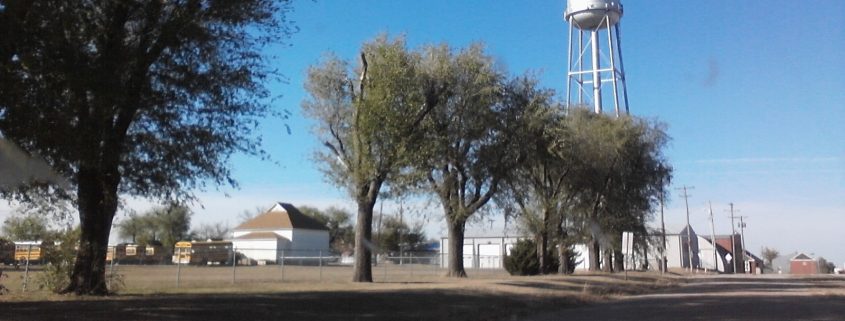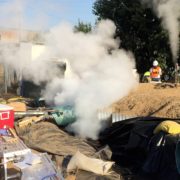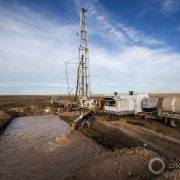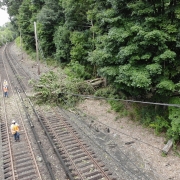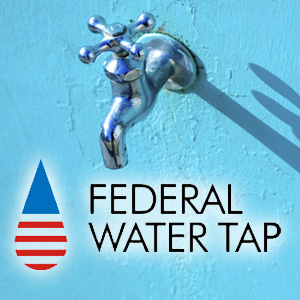Kansas Town Faces Big Bill to Clean Drinking Water
In farm country, the cost of nitrate pollution often falls on towns.
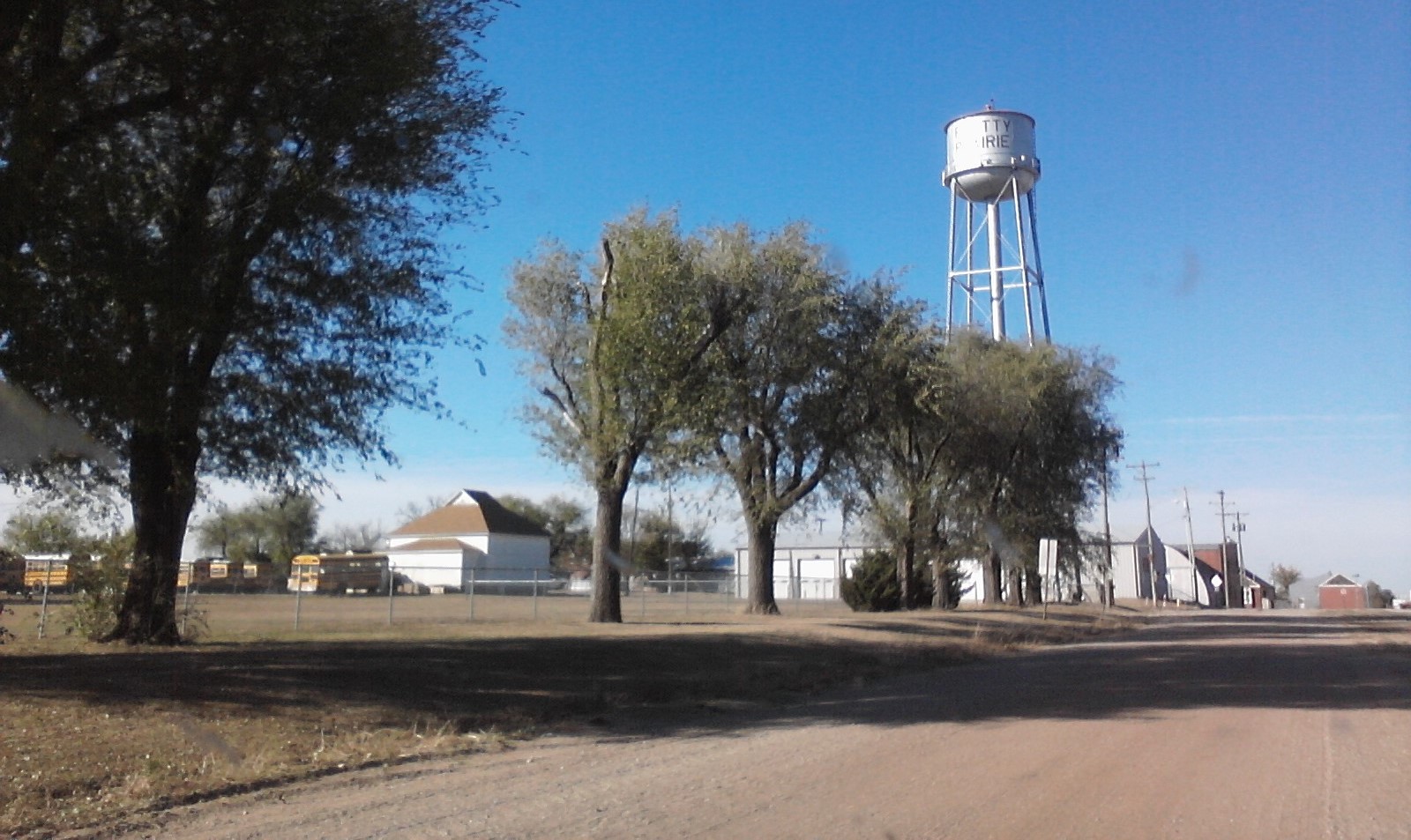
Pretty Prairie, a town in southern Kansas, exceeds the federal standard for nitrate in drinking water. Photo courtesy of Flickr/Creative Commons user bjmccray
By Brett Walton, Circle of Blue
Pretty Prairie, home to 650 people on the southern Kansas plains, is a one-well town. And that well is giving the town fits.
The 30-meter-deep (100-foot) borehole draws water from a slice of the Equus Beds aquifer that has shown increasing levels of nitrate, a chemical that can be deadly for infants. Nitrate occurs naturally in soil, but it also entered the region’s groundwater from fertilizers applied to wheat, soybean, and sorghum fields. For two decades, Pretty Prairie has violated the federal nitrate standard.
State and federal regulators for years allowed Pretty Prairie to comply with the standard by handing out bottled water to families at risk. With nitrate levels now double the federal limit, regulators are demanding stricter action. Like other towns in farm country, Pretty Prairie faces a big bill for a problem it did not cause.
Pretty Prairie’s town council voted four to one on January 3 to approve a settlement with the U.S. Department of Justice, U.S. Environmental Protection Agency, and the Kansas Department of Health and Environment. The town will spend $US 2.4 million on a reverse osmosis treatment system, a water tower, and an underground storage tank. The decision is a substantial lift for a community whose annual municipal budget is $US 1.2 million.
“It’s a rather large financial effect,” Patti Brace, the town clerk, told Circle of Blue. “We have a small number of meters to pay that off.”
Pretty Prairie applied for a $US 500,000 federal grant, but residents will shoulder most of the cost. The town tripled its water rates to pay for the upgrade, phasing in the increase over the last 18 months. The most recent rise took effect on January 1. “We were trying to prevent sticker shock,” Brace said. “We took it in small amounts.”
Nitrate in groundwater is a common struggle for farm communities in regions with sandy soils, shallow wells, and intensive irrigation. Pretty Prairie is the “poster child” for those conditions, said Elmer Ronnebaum, general manager of the Kansas Rural Water Association. Ronnebaum told Circle of Blue that numerous towns in the state have built specialized treatment facilities or relocated wells to deal with nitrate. Others are pumping less water in an effort to prevent nitrate contamination near the surface from being drawn deeper into the aquifer. Brace said Pretty Prairie considered drilling a new well, but all test wells in its area showed nitrate levels above the federal standard.
According to EPA data, some 513 U.S. water systems are violating the nitrate standard, which is 10 parts per million. Only 10 of the systems serve more than 3,300 people, the threshold for defining a small system. Eleven systems in Kansas violate the standard.
Though a problem for decades in California, Kansas, and dozens of other states, a lawsuit in Iowa has drawn national attention to nitrate contamination of drinking water. Des Moines Water Works, the capital city’s water utility, is suing drainage districts in three upstream counties for polluting the Raccoon River, its water source.
Reno County, where Pretty Prairie is located, is also an agricultural center. More than 97 percent of the county is classified as farmland. All public water systems use groundwater as their water source, as do households not on public water. Nitrate pollution is not a new phenomenon. A Kansas Geological Survey study from two decades ago fingered fertilizers as the culprit. Concentrations are higher near the surface, putting household wells and rural water systems at risk. The U.S. Geological Survey has measured rising nitrate concentrations in aquifers across the United States.
“Agriculture too frequently continues to apply nitrogen to fields without any consideration to groundwater in close proximity to drinking water supplies,” Ronnebaum said. Towns could do a better job of protecting land around their wellheads, but doing so requires technical knowledge about the direction of groundwater flows to pinpoint the source of the problem. A stronger emphasis on preventing industrial and agricultural pollution is a priority area in a U.S. Environmental Protection Agency drinking water plan that was published in December.
Some towns are already working with farmers who cultivate land near the community’s wells. Rock County Rural Water District in Minnesota, for instance, established a program that pays farmers in its wellhead protection area to plant cover crops, which take up excess nitrogen in the soil.
Does it seem unfair, Circle of Blue asked Brace, that Pretty Prairie is paying for a problem it did not cause? “Yeah, it does, it really does,” she replied. “When you know what causes it. There ought to be a relief fund for smaller communities that don’t have the number of meters to retire the debt. It’s expensive and not going to get cheaper.”
Kansas does levy a tax on fertilizer sales, and that money goes into a fund for state water planning. The fund generated $US 13.1 million in 2016, including $US 3.5 million from fertilizer fees. The fund supports farm conservation programs to reduce nutrient losses but not municipal infrastructure to remove nitrate from drinking water.
The upfront cost of a new treatment system is not the only problem for rural towns, Ronnebaum notes. Operating the unit requires a skilled, sophisticated technician — and hiring one to move to a tiny town on the plains is no easy task.
“The concern in the Midwest is out-migration,” Ronnebaum said. “A town may have the plant but no one locally is able to operate it. There’s not anyone left.”
Brett writes about agriculture, energy, infrastructure, and the politics and economics of water in the United States. He also writes the Federal Water Tap, Circle of Blue’s weekly digest of U.S. government water news. He is the winner of two Society of Environmental Journalists reporting awards, one of the top honors in American environmental journalism: first place for explanatory reporting for a series on septic system pollution in the United States(2016) and third place for beat reporting in a small market (2014). He received the Sierra Club’s Distinguished Service Award in 2018. Brett lives in Seattle, where he hikes the mountains and bakes pies. Contact Brett Walton

